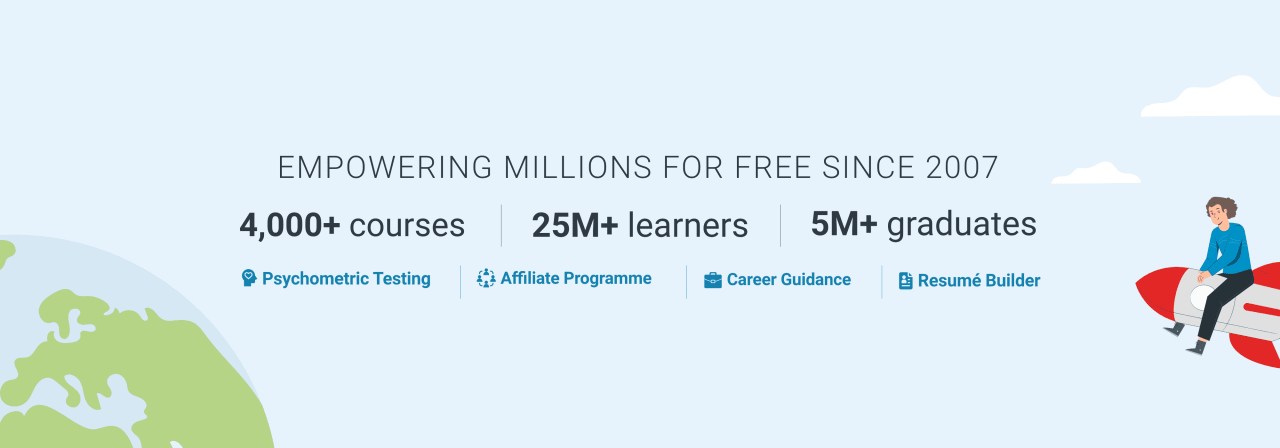
Electric Vehicle Technology (Free Online Course With Diploma)
Alison Free Online Learning

Key Information
Campus location
Online
Languages
English
Study format
Distance Learning
Duration
20 - 30 hours
Pace
Full time, Part time
Tuition fees
Request info
Application deadline
Request info
Earliest start date
Request info
* free course
Introduction
With the growing prices of fuel, electric vehicles are more popular than ever and with governments pushing car manufacturers to produce more electric vehicles, the future is in electronics. Learn about the fundamental principles of designing an electric vehicle as you begin your studies. If you are an automotive technician, mechanical or electrical engineer, or just a car enthusiast, this course is for you.
This Free Online Course Includes:
- 20-30 Hours of Learning
- CPD Accreditation
- Final Assessment
Alison Certificates
All Alison courses are free to enrol study and complete. To successfully complete this Diploma course and become an Alison Graduate, you need to achieve 80% or higher in each course assessment. Once you have completed this Diploma course, you have the option to acquire an official Diploma, which is a great way to share your achievement with the world.
Your Alison Diploma is:
- Ideal for sharing with potential employers
- Include it in your CV, professional social media profiles and job applications.
- An indication of your commitment to continuously learn, upskill & achieve high results.
- An incentive for you to continue empowering yourself through lifelong learning.
Alison offers 3 types of Diplomas for completed Diploma courses:
- Digital Diploma: a downloadable Diploma in PDF format immediately available to you when you complete your purchase.
- Diploma: a physical version of your officially branded and security-marked Diploma, posted to you with free shipping.
- Framed Diploma: a physical version of your officially branded and security-marked Diploma in a stylish frame, posted to you with free shipping.
Gallery
Scholarships and Funding
Curriculum
Several years ago, electric vehicles were seen as something that was far into the future. Today, technology has not only allowed us to make them, but they are safer, more reliable and more powerful than ever before. The biggest concern with electric vehicles is their having enough power and energy to journey from one place to another. How would one go about calculating such a feat? Matters to help calculate this include the vehicle’s weight, the passengers’ weight, road conditions, wind resistance and other forces that impact the vehicle’s performance, all of which are explored throughout this course. Understanding the physics of these forces will help you calculate the amount of torque and power an electric motor will need to overcome these forces and how much energy a battery needs to supply to achieve the power requirements specified for the vehicle.
Then you will investigate a vehicle's drive train’s role, including motors, controllers, batteries and gears. These are the elements that power the performance of the vehicle. Of course, the heart of an electric vehicle is the battery. You will discover the chemical makeup of different types of batteries and special attention will be given to the chemistry and properties of lithium-ion batteries, which is the battery of choice for electric vehicles. Afterwards, you will learn about different battery parameters and indicators. You will determine how to calculate the battery capacity, the state of charge of the battery or the percentage of charge still left in a battery so that the vehicle can inform the user how many more kilometres the vehicle can travel before it needs to recharge.
Finally, you will learn how to design a battery pack. You will explore the different types of battery cells and arrange them to form the battery pack. You will learn how to compute the amount of energy you can achieve by putting these cells together and how to build a strong and safe container for the cells. Electric Vehicles are the vehicles of the future. They are eco-friendly, less expensive to operate than conventional internal combustion vehicles and more reliable. If you are in the automotive industry or are a mechanical or electrical engineer, or find yourself simply interested in learning how electric vehicles work, this course is for you. Enrol in this ‘Diploma in Electric Vehicle Technology’ course today and be part of an ever-changing future in this exciting field.
Module 1
Vehicle Dynamics
This module will discuss which physical forces act on a moving vehicle and how to perform calculations that will help determine the power required for an engine to overcome these forces. It will also explain how to calculate the amount of energy that will be consumed by an electric vehicle, depending on driving conditions, to establish design parameters for the electric vehicle.
Module 2
Vehicle Subsystems
This module will discuss the basic functions of the electric vehicle's subsystems, including an introduction to the very heart of the electric vehicle, the battery.
Module 3
Fundamentals of Electric Vehicles - First Assessment
This assessment enables you to review your learning so you can determine your knowledge and understanding of Modules 1 and 2 from the following course: • Diploma in Electric Vehicle Technology
Module 4
Storage for Electric Vehicles
This module will discuss how to calculate battery parameters, such as battery life, range, and charging methods. It will also analyze the chemical makeup of different batteries and what to consider when designing a battery to meet certain requirements.
Module 5
Battery Pack Design
This module will discuss how to design a reliable and safe battery pack. It will explain the different stages of the design, such as cell configuration, the structure of the pack, safety, and pack control. It will also analyze the mechanical, thermal, and electrical design of the battery pack and how to implement a good Battery Management System that will monitor the battery pack.
Module 6
Fundamentals of Electric Vehicles - Second Assessment
This assessment enables you to review your learning so you can determine your knowledge and understanding of Modules 3 and 4 from the following course: • Diploma in Electric Vehicle Technology
Module 7
Course assessment
Program Outcome
What You Will Learn In This Free Course
- Define ‘gradient resistance’, ‘rolling resistance’ and ‘aerodynamic drag’.
- Compute torque and acceleration requirements for engine design.
- Solve energy requirements using drive cycles.
- Explain the function of the vehicle's drive-train.
- Compute charge-discharge cycles of an electric vehicle's battery.
- Discuss the battery capacity of electric vehicles.
- Explain the concept of ‘depth of discharge’.
- Define a battery's C-Rate.
- Explain the different components of the pack's mechanical design.
- Discuss the importance of a good thermal management system.
- Summarise how a battery pack's busbar is designed.
- Describe the role of the battery management system (BMS).
Complete This CPD Accredited Course & Get Your Diploma!
Certify Your Skills
A CPD-accredited Alison Diploma/Certificate certifies the skills you’ve learned.
Stand Out From The Crowd
Add your Alison Certification to your resume and stay ahead of the competition.
Advance in Your Career
Share your Alison Certification with potential employers to show off your skills and capabilities.
Career Opportunities
Electrical Engineer
Electrical Engineers are geniuses who apply the physics and mathematics of electricity, electromagnetism, and electronics so that innovative ideas and concepts take shape as practical devices and systems to keep everything connected at home, in businesses and in industries.
Mechanical Engineer
Mechanical Engineers play a critical role in designing and creating everything from nanotechnology to society's most significant structures, such as homes, vehicles, and space stations.